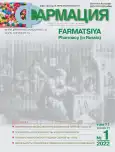Investigation of the antihistaminic activity of a liquid extract recommended for the topical therapy of eczema
- 作者: Imamaliev B.A.1
-
隶属关系:
- OOO «Med. Standart» Research Center
- 期: 卷 71, 编号 1 (2022)
- 页面: 53-56
- 栏目: Articles
- URL: https://journals.eco-vector.com/0367-3014/article/view/113622
- DOI: https://doi.org/10.29296/25419218-2022-01-08
- ID: 113622
如何引用文章
详细
Introduction. Glucocorticosteroids make up the bulk in the topical therapy of eczema today. However, topical steroids have several disadvantages associated with side effects. Therefore, there is a need for the design of the safest phytopreparations and their pharmacological study. Objective: to investigate the antihistaminic activity of a liquid extract recommended for the topical therapy of eczema. Material and methods. The antihistamine activity of the agent was investigated according to the generally accepted procedure based on the model of isolated intestinal spasm induced by histamine. The antihistamine agent gel for external use with diphenhydramine 1% was used as a reference drug. Results. The test agent was established to have a significant antihistaminic activity that was not inferior to that of the reference drug. The test agent blocked almost all the histamine receptors of the isolated intestinal specimen, which indicates that the agent has strong antihistaminic activity. Conclusion. The findings suggest that the liquid extract has a significant antihistaminic activity that is comparable to that of the reference synthetic drug.
全文:
作者简介
Bakhtiyor Imamaliev
OOO «Med. Standart» Research Center
编辑信件的主要联系方式.
Email: teokrat_1985@mail.ru
Head, Candidate of Pharmaceutical Sciences. 俄罗斯联邦,
参考
- Хайдаралиева Ш.З., Касымов О.И. Аллергологическая и иммунологическая реактивность больных экземой высокогорья. Научно-практический журнал Таджикского института последипломной подготовки медицинских кадров. 2011; 2: 73-7.
- Имамалиев Б.А. Изучение противоаллергической активности сбора «Фитоэкземадерм». Фармация. 2021; 70 (2): 51-5. DOI:10/29296/25419218-2021-02-08
- Юсупова Л.А., Юнусова Е.И., Гараева З.Ш. и др. Современные особенности клиники, диагностики и терапии больных экземой. Лечащий врач. 2018; 6: 85-7.
- Демидова М.А., Богданова Е.В.Фармакоэкономические аспекты применения антигистаминных препаратов в лечении экземы. Фармация. 2009; 2: 16-20.
- Денисова Я.Е. Современные представления о молекулярно-генетических механизмах возникновения истинной экземы. Научные ведомости Белгородского государственного университета. 2013; 18 (161), вып. 23: 85-7.
- Имамалиев Б.А. Технология жидкого экстракта фитокомплекса «Фитоаллергодерм», методом мацерации с последующим разбавлением (Сообщение №2). Фармацевтический вестник Узбекистана. 2016; 3: 71-5.
- Имамалиев Б.А. Технология жидкого экстракта фитокомплекса «Фитоэкземадерм», методом мацерации с последующим разбавлением. Фармацевтический вестник Узбекистана. 2017; 3: 20-4.
- Государственная фармакопея РФ XIV изд. [Электронное издание]. Режим доступа: http://femb.ru/feml
- Руководство по проведению доклинических исследований лекарственных средств. Часть 1 (под ред. А.Н. Миронова). М.: Гриф и К, 2012; 944.
补充文件





